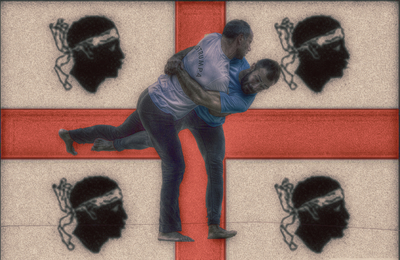
S'istrumpa (Sardinia)
- Name of sport (game): S'istrumpa
- Name in native language: Sa Strumpa or s’Istrumpa or Lotta Sarda
- Place of practice (continent, state, nation):
Sardinia
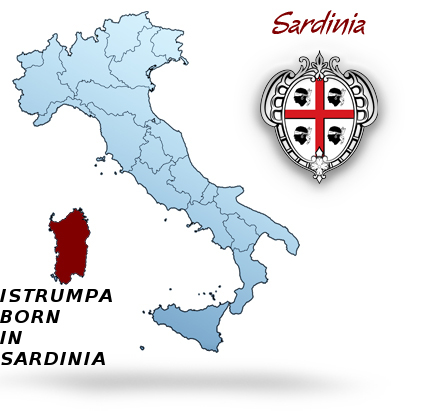
- History:
Sa STRUMPA or s’ISTRUMPA, which is also known as the LOTTA SARDA (Sardinian Wrestling) is an ancient folk wrestling style culturally unique to the Sardinian people (the Sardinians, or the Sards). Its principles have been passed for centuries, primarily through practice and stories that from generation to generation descides the achievements of legendary characters.
The Sardinians trace their origin to the times of the pharaohs and were called SHARDANA, who belonged to the People of the Sea and believed to be the guards of the pharaohs of Egypt. The Sardinian people more likely have a Sumerian origin. This is supported by the structures called "Nuraghe" in the singular and "nuraghes" in the plural which can be found in different places all over Sardinia and which were erected long before the arrival of the Romans to that territory. In fact, the shape of those buildings recalls the cylindrical towers of Babylon, whose inhabitants the Babylonians had Sumerian origins. Among the most famous historical sites of Sardinia is the "ziqqurat" of Monte d'Accoddi, a former ancient temple which is unique not only to Europe, but to the whole entire Mediterranean region. It is located at the Monte d'Accoddi, in the Nurra, North-Western region of Sardinia, Canton of Logudoro. It’s appearance has a strong physical resemblance with those of the Mesopotamian ziqqurat temples.
When the Romans first arrived to Sardinia they settled on a territory in the North-West of Sardinia, which took the name of Romangia (also in Logudoro) which stands for Roman territory. Since Romans failed to colonize the hinterland areas of Sardinian they called it "Barbagia" which stands for "barbarian/uncivilized” territory.
Sardinia consists of quite a few micro-regions, for example Nurra and Romangia, which in turn are grouped into macro-regions, also called "cantons" and there are four of them: LOGUDORO, GALLURA, BARBAGIA and CAMPIDANO.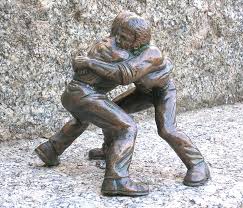
Sa Strump ("istrumpare" - instruct, literally "thrown on the ground") is described by researchers of the past as part of "living archeology." It is part of the history of the Sardinia, which is three thousand years old and it is based on courage, loyalty and respect for the rules. There are several testimonies of this sport created over the centuries, with finds such as Uta from a nuragic bronze depicting "gherradores" and about thirty warriors, archers, wrestlers and boxers and is over two meters high, discovered in 1974 in Monti Prama, in Sinis, dated VIII or VII century BC.
In 1985, to organize the first Istrumpa tournament, elderly people from Ollolai and neighboring regions conducted a search to obtain the necessary information to develop "modern" rules. It turned out that in the traditional fight of previous generations there were no written rules, neither weight classes nor duration of fight. Players often fought until they won, while one or both gave up with exhaustion. Victory was awarded after two wins from three clashes or three out of five. Weight categories and combat times were established, and the first technical regulations for this sport were developed. On its basis, in the same year, the first regional championships were organized, which were met with great favor of public opinion and the participation of athletes from many centers in the Sardinia.
In 1994, Federazione S’istrumpa was founded, which in 1995 was incorporated into the FILC (International Federation of Celtic Wrestling). Finally in 1997, Federazione S’istrumpa was included in the FILJKAM (Federazione Italiana Judo Lotta Karate Arti Marziali).
Among the most famous practitioners of the "su chintu partidu/chintzu partziu" variation of the Strumpa wrestling was a two-time Mr. Olympia winning bodybuilder Franco Columbu (1941-2019) of Ollolai, Barbagia and Barbagia, Sardinia.
- Description:
This type of fight has kept its traditional rules and techniques. In the whole Sardinia it was practiced it in a similar way: for example "a manu and inthu", "inthu after inthu", "inthu partiu." The initial position is identical throughout the Sardinia: the warriors face each other half-bent forward, legs slightly buckle and slightly splay, one arm under the opponent's armpit, the other shoulder on the opponent’s shoulder to hold hands behind his back by the wrists or fingers. In another variation of this fight opponents are holding the belt.
The given below description and ruleset of the variation of the Strumpa Lotta Sarda" is present as it is practiced by the residents of Campidano (a plain located in South-Western Sardinia between Cagliari and Oristano) and adjacent areas such as Ogliastra (but not by the inhabitants of the other cantons such as Logudoro, Gallura and Barbagia) and where it is known as the STRUMPA or "sa Campidanesa.”
The wrestlers ("Gherradore" in the singular, "gherradores" in the plural) competed barefoot and were wearing canvas jackets, pants, and belts.
Below are the generally accepted wrestling modes of the STRUMPA CAMPIDANESE or "sa Campidanesa."
1. BRATZAS or BRATZOS or "a sa MUSINADA” Only following holds of the jackets are allowed: by the collar of the jacket, by the lapels of the jacket, by the sleeves of the jacket and around the biceps/triceps.
2. CHINTU PARTIDU or CHINTZU PARTZIU an equal back-hold grip, hooking legs and tripping being allowed. This variation of Strumpa is an official sport recognized by FIJLKAM. It also was practiced in the past, if both fighters mutually agreed on that.
3. In CHINTZU LIMPIU version, the wrestlers started at a distance from each other and the one who first takes a grip by the belt (not the trouser’s belt) took the lead. The tightening could cause his opponent lose his breath and could crush him to the ground. Other holds such as arm / head, arm / arm and arm / under-arm were allowed. Most likely it was CHINTZU LIMPIU that was called "sa CAMPIDANESA".
4. In this variation of Strumpa the wrestlers take holds of trouser’s belt and it is called CHINTADA / CHINTA CHINTA / CHINTA since CHINTOLZA or CHINTORZA means BELT of the pants. The wrestlers take holds of the trouser’s belt the socket of the hips, with the right arm under the opponent's left arm and the left arm above the other's right arm, and right cheek against right cheek.
The STRUMPA wrestling techniques are called TRASSAS ie "abilities", while unfair actions are called TRAMPAS. The Sa ZANGA, in reality, has the literal meaning of "cause", in the sense of a reason which causes the fall to the ground. The common Back Heel tripping is called CARCANGIU or CALCANZU.
The Strumpa Lotta Sarda matches are contested for the back falls. The back fall is when one of the two wrestlers is thrown down flat on his back.
The side falls, according to FIJLKAM regulations do not count. For the throw to be counted, the attacker must fall on top of his opponent. If the attacker will let go his hold before landing the throw is not counted even if the opponent touches the ground with his back.Pietropaolo De Montis presenting the techniques of s'istrumpa:
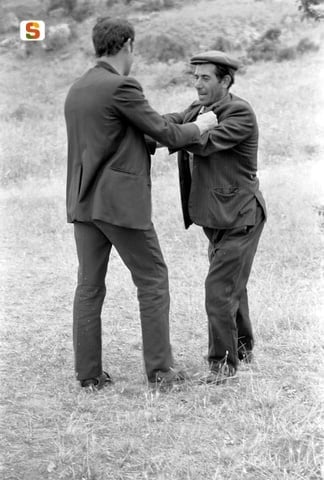
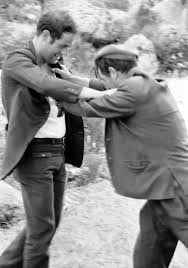
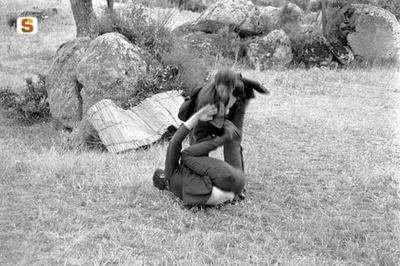
- Current status:
The Strumpa Sardinian wrestling gatherings traditionally were held not so much for the passion of this discipline (sport) but to demonstrate one's personal "value" in their own community (or "balentia"; su "bulente"). In fact it was a “man of value” who inclines to do good for his people. There also were wrestling meetings where the "money bets" were made which was barely legal.
In recent years, in addition to Ollolai, tournaments have been organized in various other centers, such as Fonni, Sardara, Ozieri, Dorgali, Villamassargia, Villagrande, Oliena, Urzulei, Lanusei, Sorgno, Tertenia, Tonara, Orosei, Thiesi, as well as shows at Baratile, Oristano, Cagliari, Sassari, Nuoro, Desulo, Olbia and Monti.
The sport of Strumpa is officially recognized by the Italian Federation of Judo, Karate and Martial Arts (FIJLKAM). The STRUMPA was placed within the Martial Arts sector of the FIJLKAM. Just like any other traditional sport it’s defined by its proper name, cultural identity and unique set of rules. The Strumpa wrestlers participate in the international tournaments organized by the FILC (International Federation of Celtic Wrestling). - Importance (for practitioners, communities etc.):
In the popular tradition, there were many opportunities to try s'istrump: rural feasts, haircuts, grape harvest, threshing, weddings, military visits, military rallies, etc. S'istrumpa sometimes served as entertainment and fun. In addition, it has always been recognized as an educational value, tests that involved children were carried out under the vigilant supervision of fathers and the elderly.
- Contacts:
FIJLKAM (Federazione Italiana Judo Lotta Karate Arti Marziali)
Via dei Sandolini, 79
00122 Ostia Lido
Fax: 06/56434801
Webside: https://www.fijlkam.it/
Fb: https://www.facebook.com/fijlkam
Twitter: https://twitter.com/FijlkamOfficial
Instagram: https://www.instagram.com/fijlkam_official/
YouTube: https://www.youtube.com/user/FIJLKAMchannel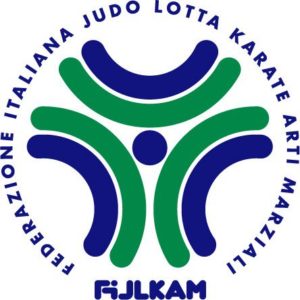
- Sources of information :
Thank you for the information A.S.D. Polisportiva Gigliotti Team of Nuoro, which promotes martial arts. Great work by three brothers: Giovanni, Marco, Edoardo Gigliotti, who are athletes and coaches (highly decorated Champions in Sardini, Italy and worldwide).
Facebook link: https://it-it.facebook.com/PolisportivaGigliottiTeamNuoro/
Site: https://sites.google.com/site/polisportgigliotti/Materials of Italian pro-wrestler Mr. Michele (Mike) Raho of Bergamo.
Articles:
https://www.fijlkam.it/arti-marziali/s-istrumpa/storia-s-intrumpa.html
Rules: https://www.fijlkam.it/arti-marziali/s-istrumpa/regolamento.htmlVideo:
https://www.youtube.com/watch?v=pYE7aorBqGo&feature=youtu.be&fbclid=IwAR0I77IQihJy1moSjZtkaZFxDR4iG5Ci3G5dMGgu--3-u-OspJuY3v52TuM
https://www.youtube.com/watch?v=wNko02ZFN84
https://www.youtube.com/watch?v=pYE7aorBqGo - Gallery:
- Documents:

